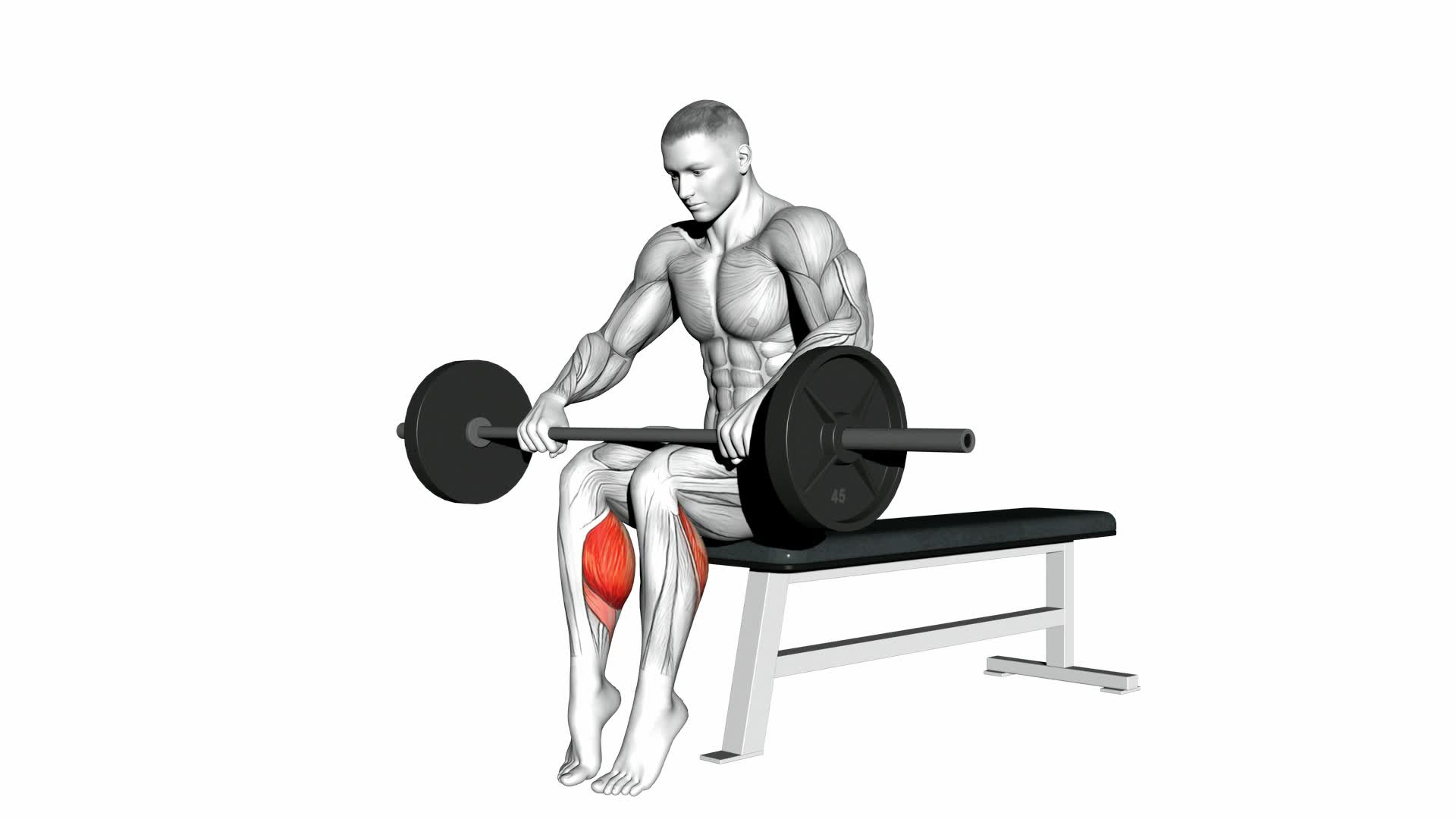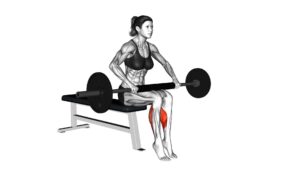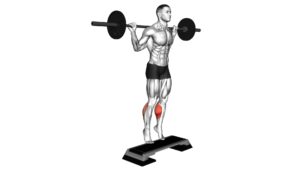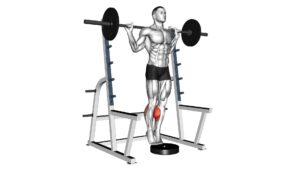Barbell Seated Calf Raise – Video Exercise Guide & Tips

Are you looking to strengthen your calf muscles? Look no further than the barbell seated calf raise! This exercise targets your calves, helping to improve stability and performance in activities like running and jumping.
Watch This Exercise Video
All you need is a barbell and a bench to get started. In this article, we'll guide you through the proper form and technique, share some common mistakes to avoid, and provide tips for increasing the intensity.
Let's get those calves in shape!
Key Takeaways
- Barbell seated calf raises can increase calf muscle strength and improve balance and stability.
- Proper foot placement, with toes pointing forward and heels slightly lower than the balls of the feet, is important for maintaining proper form during the exercise.
- Ankle flexibility and range of motion are crucial for performing the exercise correctly, and exercises to improve ankle flexibility should be prioritized.
- To maximize the benefits of barbell seated calf raises, it is important to avoid common mistakes such as using excessive weight, compromising form, and rushing through the movement. Additionally, progressive overload techniques and proper rest and recovery strategies can help increase intensity and track progress.
Benefits of Barbell Seated Calf Raise
One benefit of the Barbell Seated Calf Raise is increased calf muscle strength. This exercise targets the muscles in your calves, specifically the gastrocnemius and soleus muscles. By performing the Barbell Seated Calf Raise, you can effectively build and strengthen these muscles, leading to improved balance, stability, and power in your lower legs.
To maximize the benefits of the Barbell Seated Calf Raise, you can incorporate variations and progressive overload techniques into your routine. Variations such as using different foot positions or adjusting the angle of the bench can help target different areas of the calves and prevent plateauing. Progressive overload techniques, such as increasing the weight or the number of repetitions over time, can challenge your muscles and stimulate growth.
By consistently incorporating the Barbell Seated Calf Raise into your workout routine and utilizing variations and progressive overload techniques, you can see significant improvements in your calf muscle strength and overall lower body performance.
Now that you understand the benefits of the Barbell Seated Calf Raise, let's move on to the equipment needed for this exercise.
Equipment Needed for the Exercise
To perform the Barbell Seated Calf Raise, you'll need a barbell, a weight plate, and a bench. These three pieces of equipment are essential for properly executing this exercise and targeting your calf muscles effectively.
Here are the benefits of using a barbell for calf raises and the different types of calf raise equipment:
- Benefits of using a barbell for calf raises:
- Increased resistance: The barbell allows you to add more weight, providing a greater challenge to your calf muscles and promoting strength gains.
- Stability and control: Holding a barbell provides stability, allowing you to maintain proper form throughout the exercise.
- Progressive overload: With a barbell, you can easily increase the weight as you progress, continually challenging your calves and promoting muscle growth.
- Different types of calf raise equipment:
- Dumbbells: Using dumbbells instead of a barbell can provide a similar effect, but may be more challenging to balance.
- Calf raise machines: These machines are specifically designed for calf exercises and often have adjustable resistance levels.
- Smith machine: The Smith machine allows you to perform calf raises with added stability and control, as the barbell is fixed on a vertical track.
Proper Form and Technique
To perform the barbell seated calf raise with proper form and technique, there are a few key points to keep in mind.
First, foot placement is crucial as it determines which part of the calf muscle you target.
Second, having good ankle flexibility is important for achieving a full range of motion during the exercise.
Lastly, focusing on controlled movements and avoiding bouncing or jerking will help you get the most out of this calf-strengthening exercise.
Foot Placement Importance
To achieve proper form and technique during the Barbell Seated Calf Raise exercise, focus on the positioning of your feet. The importance of form and foot placement techniques can't be overstated. Here are some key points to keep in mind:
- Place your feet hip-width apart on the foot platform.
- Ensure that your toes are pointing forward.
- Keep your heels slightly lower than the balls of your feet.
- Maintain a neutral spine throughout the exercise.
- Avoid bouncing or jerking motions and perform the movement in a controlled manner.
By paying attention to your foot placement, you can maximize the effectiveness of the exercise and minimize the risk of injury.
Now, let's move on to the next section, which discusses the ankle flexibility requirement for the Barbell Seated Calf Raise.
Ankle Flexibility Requirement
You need sufficient ankle flexibility to maintain proper form and technique during the Barbell Seated Calf Raise exercise. Ankle mobility plays a crucial role in this exercise as it allows your foot to move through a full range of motion.
When your ankles have limited mobility, it can lead to compensatory movements and decrease the effectiveness of the exercise. Adequate ankle flexibility ensures that your calf muscles are properly activated during the movement.
To improve ankle flexibility, you can incorporate exercises such as ankle circles, calf stretches, and calf raises on a step. It's important to prioritize ankle mobility to ensure optimal calf muscle activation and prevent any potential injuries during the Barbell Seated Calf Raise exercise.
Range of Motion Tips
Maintaining a full range of motion is crucial for proper form and technique during the Barbell Seated Calf Raise exercise, ensuring optimal activation of your calf muscles. Here are some range of motion tips to help you get the most out of this exercise:
- Start by placing your feet on the edge of a sturdy platform, with your toes pointing forward.
- Lower the barbell slowly towards your ankles, feeling a stretch in your calves.
- Pause for a moment at the bottom, then raise your heels as high as possible by contracting your calf muscles.
- Hold the top position briefly, focusing on squeezing your calf muscles.
- Slowly lower your heels back down to the starting position, maintaining control throughout the movement.
By maintaining a full range of motion, you'll experience the benefits of increased muscle activation and flexibility in your calf muscles.
Now, let's discuss some common mistakes to avoid during the Barbell Seated Calf Raise exercise.
Common Mistakes to Avoid
One common mistake to avoid when performing the barbell seated calf raise is using too much weight. While it may be tempting to load up the barbell with heavy plates, doing so can compromise your form and increase the risk of injury. It's important to remember that the focus of this exercise is to target the calf muscles specifically, and using excessive weight can shift the load onto other muscles, such as the lower back or hips.
Another common mistake isn't maintaining proper technique throughout the movement. It's crucial to keep your feet flat on the foot platform and ensure that the barbell is resting securely on your thighs. In addition, avoid rushing through the exercise and instead focus on controlling the movement and contracting the calf muscles at the top of the exercise.
It is also important to avoid bouncing at the bottom of the movement or using momentum to lift the weight. This not only reduces the effectiveness of the exercise but also increases the risk of injury. Instead, maintain a slow and controlled motion throughout the entire range of motion, allowing the calf muscles to fully stretch and contract.
Tips for Increasing Intensity
To increase the intensity of your barbell seated calf raises, there are several key tips you can follow.
First, make use of progressive overload techniques such as adding more weight or increasing the number of reps.
Secondly, ensure that you maintain proper form and technique throughout the exercise to effectively target your calf muscles.
Lastly, don't forget to prioritize rest and recovery strategies to allow your muscles to repair and grow stronger.
Progressive Overload Techniques
To increase the intensity of your barbell seated calf raise, you can progressively overload the exercise by gradually adding weight to the barbell. This technique is effective in overloading your calf muscles and breaking through training plateaus.
Here are five tips for implementing progressive overload:
- Start with a weight that allows you to perform the exercise with proper form.
- Once you can comfortably complete the desired number of repetitions, increase the weight by 5-10%.
- Aim to add weight every 1-2 weeks to continually challenge your muscles.
- If you can't increase the weight, focus on increasing the repetitions or sets.
- Keep track of your progress to ensure gradual and consistent overload.
Proper Form and Technique
To increase the intensity of your barbell seated calf raise and maximize the benefits of progressive overload, it's important to focus on maintaining proper form and technique throughout the exercise. This won't only help prevent injury but also ensure that you're effectively targeting and engaging your calf muscles.
One common mistake to avoid is using too much weight and sacrificing form. It's crucial to start with a weight that allows you to perform the exercise with control and full range of motion.
Another mistake isn't fully extending your ankles at the top of the movement. To increase the intensity, try adding a pause at the top and bottom of each repetition or incorporating a slow eccentric phase.
Remember to always listen to your body and adjust the weight and technique accordingly.
Rest and Recovery Strategies
To optimize the intensity of your barbell seated calf raise and increase your gains, it's crucial to implement effective rest and recovery strategies. Here are some recovery techniques that can help you minimize muscle soreness and maximize your results:
- Allow for proper rest between workouts to give your muscles time to recover and rebuild.
- Incorporate active recovery activities such as light cardio or stretching on your rest days to promote blood flow and reduce muscle stiffness.
- Get enough sleep each night to support muscle repair and growth.
- Consider using foam rollers or massage tools to help alleviate muscle soreness and improve flexibility.
- Stay hydrated and fuel your body with nutritious foods to support recovery and optimize performance.
Variations and Modifications
Try incorporating different variations and modifications into your barbell seated calf raise routine to challenge your calf muscles in new ways. By changing up the exercise, you can target different areas of your calves and avoid plateaus in your training.
One variation you can try is the single-leg seated calf raise. This involves performing the exercise with one leg at a time, which increases the intensity and balance required.
Another variation is the donkey calf raise, where you position yourself on a raised surface and have someone place a weight on your back. This targets your calves from a different angle and adds more resistance.
You can also modify the exercise by using dumbbells or a resistance band instead of a barbell. This allows for a greater range of motion and can help improve stability.
Additionally, you can try performing the exercise on a step or an incline to change the angle and increase the difficulty.
Remember to start with lighter weights and gradually increase as you become more comfortable with each variation and modification.
Frequently Asked Questions
How Many Sets and Reps Should I Do When Performing the Barbell Seated Calf Raise?
When performing the barbell seated calf raise, it's important to determine the right number of sets and reps for optimal results. The number of sets and reps can vary depending on your fitness goals and current strength level.
It's generally recommended to start with 3-4 sets of 8-12 reps. As you progress, you can increase the number of sets or reps to continue challenging your calves and promoting muscle growth.
Remember to listen to your body and adjust as needed.
Can I Perform the Barbell Seated Calf Raise Without Using a Barbell?
Yes, you can perform the barbell seated calf raise without using a barbell. There are alternative exercises you can do, such as seated calf raises with dumbbells or using a calf raise machine.
However, using a barbell has its benefits. It allows for greater resistance and helps build strength and muscle mass in your calves.
Are There Any Alternative Exercises That Target the Calf Muscles?
There are several alternative exercises that target the calf muscles. These exercises include standing calf raises, calf raises on a leg press machine, and seated calf raises using dumbbells.
Incorporating these exercises into your workout routine can help strengthen your calf muscles. Strong calf muscles offer benefits such as improved balance, stability, and power in activities like running and jumping.
What Are Some Ways to Prevent Muscle Cramps During the Barbell Seated Calf Raise?
To prevent muscle cramps during the barbell seated calf raise, there are a few tips you can follow.
First, make sure to stay properly hydrated throughout your workout. Dehydration can contribute to muscle cramps.
Second, warm up your calves before starting the exercise to increase blood flow and flexibility.
Lastly, listen to your body and don't push yourself too hard. If you start feeling any pain or discomfort, take a break and stretch your calves to prevent cramps.
Is It Necessary to Use a Spotter When Doing the Barbell Seated Calf Raise?
When performing the barbell seated calf raise, it isn't necessary to use a spotter.
However, it's important to maintain proper form and technique to prevent injury. Make sure to keep your back straight, knees slightly bent, and heels on the edge of the platform.
Use a weight that challenges you but allows you to complete the exercise with control.
If you're unsure about your form or feel uncomfortable, it may be helpful to have someone nearby to provide spotter assistance.
Conclusion
In conclusion, the barbell seated calf raise is a highly effective exercise for targeting and strengthening the calf muscles.
By using proper form and technique, avoiding common mistakes, and following the tips for increasing intensity, you can maximize the benefits of this exercise.
Additionally, variations and modifications can be incorporated to add variety and challenge to your calf training routine.
Incorporate the barbell seated calf raise into your workouts to improve calf strength and enhance overall lower body performance.

Author
Years ago, the spark of my life’s passion ignited in my mind the moment I stepped into the local gym for the first time. The inaugural bead of perspiration, the initial endeavor, the very first surge of endorphins, and a sense of pride that washed over me post-workout marked the beginning of my deep-seated interest in strength sports, fitness, and sports nutrition. This very curiosity blossomed rapidly into a profound fascination, propelling me to earn a Master’s degree in Physical Education from the Academy of Physical Education in Krakow, followed by a Sports Manager diploma from the Jagiellonian University. My journey of growth led me to gain more specialized qualifications, such as being a certified personal trainer with a focus on sports dietetics, a lifeguard, and an instructor for wellness and corrective gymnastics. Theoretical knowledge paired seamlessly with practical experience, reinforcing my belief that the transformation of individuals under my guidance was also a reflection of my personal growth. This belief holds true even today. Each day, I strive to push the boundaries and explore new realms. These realms gently elevate me to greater heights. The unique combination of passion for my field and the continuous quest for growth fuels my drive to break new ground.







